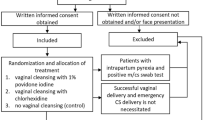Abstract
Purpose
To determine whether preoperative vaginal cleansing with iodine-based solution prior to hysteroscopy, reduces postoperative infection rate compared to no vaginal cleansing.
Methods
A retrospective study at a single tertiary, university affiliated hospital of all individuals who have had an office hysteroscopy. Study group consisted of patients who have had preoperative vaginal cleansing with iodine-based solution and were compared to those who have not. Any procedural related complaints at the 30 days following the hysteroscopy were recorded.
Results
A total of 505 were available for analysis, 183 in the study group and 322 in the control group. The most common indications for operation were infertility evaluation (33.9% vs. 28.6%) and retained products of conception (33.3% vs. 29.2%), and most common procedures were diagnostic only (49.7% vs. 42.5%) followed by adhesiolysis (12% vs. 14.3%).
No statistical differences were noted with regards to postoperative infections, as only one case of pelvic inflammatory disease was noted, in the iodine cleansing group (0.19% for postoperative infection).
Conclusion
Our comparative study may suggest that the use of preoperative iodine solution prior to office hysteroscopy does not decrease the postoperative infection rate up to 30 days, thus can be avoided.
Similar content being viewed by others
Data availability
The data that support the findings of this study are available from the corresponding author, upon reasonable request.
References
Campo R, Santangelo F, Gordts S et al (2018) Outpatient hysteroscopy. Facts Views Vis Obgyn 10:115–122
Smith PP, Kolhe S, O’Connor S et al (2019) Vaginoscopy against standard treatment: a randomised controlled trial. BJOG 126:891–899
Salazar CA, Isaacson KB (2018) Office operative hysteroscopy: an update. J Minim Invasive Gynecol 25:199–208
Florio P, Nappi L, Mannini L et al (2019) Prevalence of infections after in-office hysteroscopy in premenopausal and postmenopausal women. J Minim Invasive Gynecol 26:733–739
Muzii L, Donato VD, Tucci CD et al (2020) Efficacy of antibiotic prophylaxis for hysteroscopy: a meta-analysis of randomized trials. J Minim Invasive Gynecol 27:29–37
American College of Obstetricians and Gynecologists and others (2020) The use of hysteroscopy for the diagnosis and treatment of intrauterine pathology: ACOG committee opinion number 800. Obstet Gynecol 135:e138–e148
Royal College of Obstetricians and Gynaecologists. Best Practice in Outpatient Hysteroscopy, Green Top 59, RCOG
Deffieux X, Gauthier T, Menager N et al (2014) Hysteroscopy: guidelines for clinical practice from the french college of gynaecologists and obstetricians. Eur J Obstet Gynecol Reprod Biol 178:114–122
Zimmer M, Pomorski M, Kamiński P et al (2019) Polish society of gynecologists and obstetricians guidelines for the application of hysteroscopy in gynecology. Ginekol Pol 90:482–489
ACOG practice bulletin no (2018) 195: prevention of infection after gynecologic procedures. Obstet Gynecol 131:e172–e189
Gregoriou O, Bakas P, Grigoriadis C et al (2012) Antibiotic prophylaxis in diagnostic hysteroscopy: is it necessary or not? Eur J Obstet Gynecol Reprod Biol 163:190–192
Jansen FW, Vredevoogd CB, van Ulzen K et al (2000) Complications of hysteroscopy: a prospective, multicenter study. Obstet Gynecol 96:266–270
The Society for Hospital Epidemiology of America; The Association for Practitioners in Infection Control; The Centers for Disease Control; The Surgical Infection Society (1992) Consensus paper on the surveillance of surgical wound infections. Infect Control Hosp Epidemiol 13:599–605
Aas-Eng MK, Langebrekke A, Hudelist G (2017) Complications in operative hysteroscopy-is prevention possible? Acta Obstet Gynecol Scand 96:1399–1403
Damiani GR, Pellegrino A, Seghezzi U et al (2012) A dangerous trigger. Eur J Obstet Gynecol Reprod Biol 165:133–134
Damiani GR, Landi S, D’Addario V et al (2013) Pivotal points to prevent iatrogenic infections triggered by hysteroscopy. Aust N Z J Obstet Gynaecol 53:99–100
De Silva PM, Mahmud A, Smith PP et al (2020) Analgesia for office hysteroscopy: a systematic review and meta-analysis. J Minim Invasive Gynecol 27:1034–1047
Fouks Y, Kern G, Cohen A et al (2022) A virtual reality system for pain and anxiety management during outpatient hysteroscopy-a randomized control trial. Eur J Pain 26:600–609
Rastogi S, Glaser L, Friedman J et al (2020) Tolerance of chlorhexidine gluconate vaginal cleansing solution: a randomized controlled trial. J Gynecol Surg 36:13–19
Lewis LA, Lathi RB, Crochet P et al (2007) Preoperative vaginal preparation with baby shampoo compared with povidone-iodine before gynecologic procedures. J Minim Invasive Gynecol 14:736–739
Abbas AM, Shaltout AS, Ali SS et al (2017) Povidone–iodine versus normal saline solution in preoperative vaginal cleansing before office hysteroscopy: a randomized controlled trial. Int J Reprod Contracept Obstet Gynecol 7:5
Acknowledgements
We would like to thank Ms. Perach Chen Elkayam, from the Department of Community Medicine and Epidemiology, the Lady Davis Carmel Medical Center, for her aid in statistical computation and analysis.
Funding
The authors declare that no funds, grants, or other support were received during the preparation of this manuscript.
Author information
Authors and Affiliations
Contributions
NC: Protocol development, data collection, manuscript writing. HK: Data collection, manuscript reviewing. LAF: Data collection, manuscript reviewing. MP: Manuscript reviewing. YK: Manuscript reviewing. OL: Manuscript reviewing. AZ: Protocol development, manuscript writing. All authors contributed to the study conception and design. Material preparation, data collection and analysis were performed by NC, HIK and LAF. The first draft of the manuscript was written by NC, and all authors commented on previous versions of the manuscript. All authors read and approved the final manuscript.
Corresponding author
Ethics declarations
Conflict of interest
The authors have no relevant financial or non-financial interests to disclose.
Additional information
Publisher's Note
Springer Nature remains neutral with regard to jurisdictional claims in published maps and institutional affiliations.
Rights and permissions
Springer Nature or its licensor (e.g. a society or other partner) holds exclusive rights to this article under a publishing agreement with the author(s) or other rightsholder(s); author self-archiving of the accepted manuscript version of this article is solely governed by the terms of such publishing agreement and applicable law.
About this article
Cite this article
Cohen, N., Kedem, H.I., Abu-Foul, L. et al. Does vaginal cleansing with iodine decreases infection rate in office hysteroscopy?. Arch Gynecol Obstet 308, 1791–1796 (2023). https://doi.org/10.1007/s00404-023-07199-y
Received:
Accepted:
Published:
Issue Date:
DOI: https://doi.org/10.1007/s00404-023-07199-y




